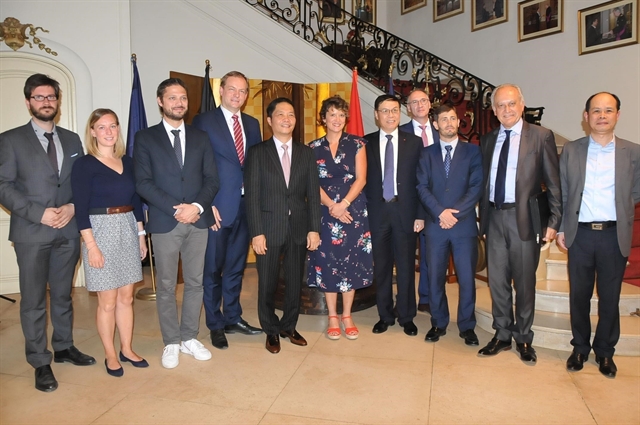January 7, 2019
Bruno Angelet, Ambassador and head of the European Union Delegation
to Vietnam, told VIR that the European Council is now considering the
signing of the EU-Vietnam Free Trade Agreement (EVFTA), which will then
be submitted to the European Parliament for adoption.
In October 2018 the European Commission (EC) adopted the EVFTA and
the EU-Vietnam Investment Protection Agreement (IPA). The two texts
were then submitted to the European Council the following month for
official signature.
“Now in Brussels, member states in the council are reviewing the
agreement and we hope that by February or March 2019, they can endorse
the deal. I am sure the deal will be signed,” Angelet confirmed. “If
everything goes smoothly, EU Trade Commissioner Cecilia Malmström will
come to Vietnam for the signing.”
But Angelet noted that in May 2019, the European bloc will have an
election for a new parliament. “The latest time the EVFTA can be
ratified is in April. If the existing parliament cannot sign in April,
or maybe in May or June, then the next parliament will do so.”
In addition to considering the EVFTA signing, the EU will have to
push itself to adopt its bilateral FTA with Singapore signed in October
2018, its first FTA with an ASEAN nation.
Once the European Council agrees to sign, the next step will be European Parliament consent.
“In practice this means the parliament will have very little time for
deliberations before the end of its current term in April 2019, which
means ratification and entry into force of the EVFTA may have to wait
until autumn 2019, and the IPA will take longer due to the requirement
for member state ratification,” the parliament said on its website.
However, according to Vietnamese Deputy Minister of Foreign Affairs
Bui Thanh Son, the Vietnamese government will continue working with the
European Union to “sign and adopt the EVFTA as soon as is feasibly
possible, especially before May 2019 when the EU parliament election
take places.”
Great benefits
The EVFTA will eliminate virtually all tariffs on goods traded
between the two sides (see below). It also includes a strong,
legally-binding commitment to sustainable development, including the
respect of human rights, labor rights, environmental protection and the
fight against climate change, with an explicit reference to the Paris
Agreement.
According to the European Parliament, the EU hopes that the FTA with Vietnam will boost trade and investment.
“The FTA is also an important stepping stone to a wider EU-Southeast
Asia trade deal, something which the EU has been striving towards for
nearly a decade,” the parliament said. “Vietnam, a fast-growing and
competitive economy whose bilateral trade with the EU has quintupled
over the past 10 years, is equally keen on the deal, which could
potentially boost its GDP by 15 percent.”
“The trade and investment agreements with Vietnam are exemplary of
Europe’s trade policy. They bring unprecedented advantages and benefits
for European and Vietnamese companies, workers and consumers. They take
fully into account the economic differences between the two sides,” said
Jean-Claude Juncker, President of the EC.
In particular, according to the EC, the EVFTA will create parity for EU companies and innovative products.
“The EVFTA will level the playing field between state-owned
enterprises and private enterprises when state-owned enterprises are
engaged in commercial activities,” said an EC document on the EVFTA.
“There are also rules on transparency, and consultations on domestic
subsidies. These are the most ambitious rules that Vietnam has ever
agreed to in an international deal.”
On intellectual property rights, Vietnam has committed to a high
level of protection going beyond standards of the World Trade
Organization Trade-Related Aspects of Intellectual Property Rights
agreement. With this, EU innovations, artworks and brands will be better
protected against being unlawfully copied, including through stronger
enforcement provisions.
The EU pharmaceutical sector in particular will benefit from improved
protection of test data and from the possibility to get an extension of
the term of the patent up to two years if there are delays in marketing
authorization.
Vietnam has also taken on ambitious commitments concerning the
procurement of pharmaceutical products, for instance allowing companies
with European capital to import and sell medicines to distributors and
wholesalers within the country.
source: vir.com.vn





